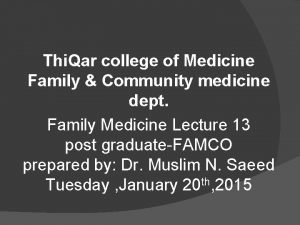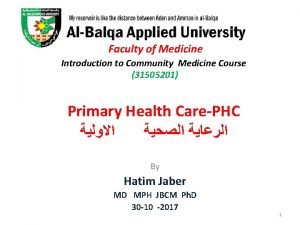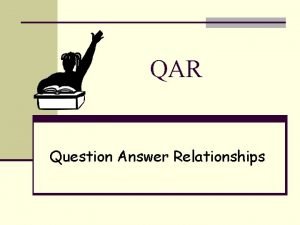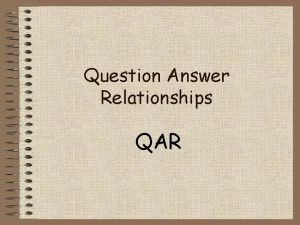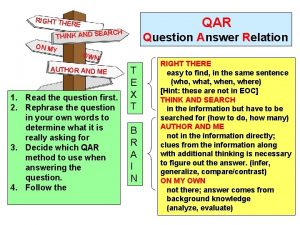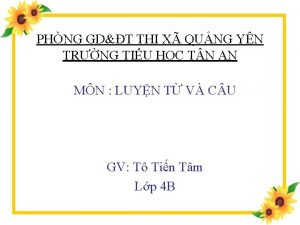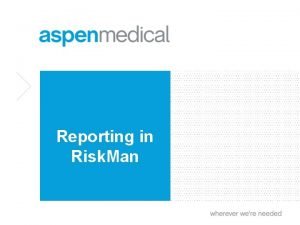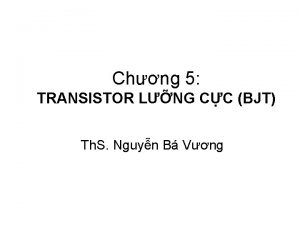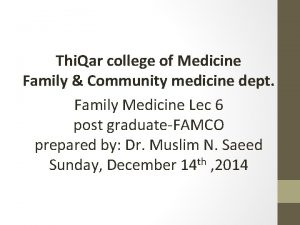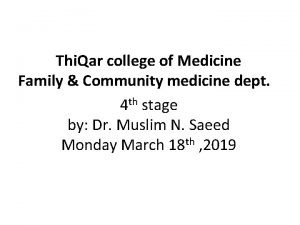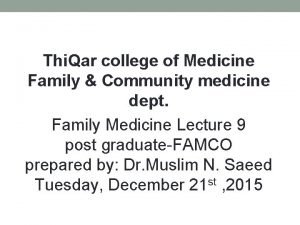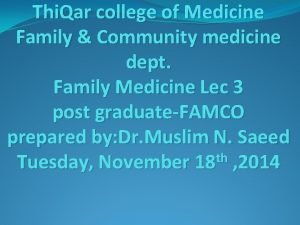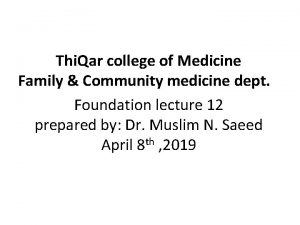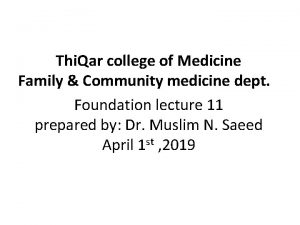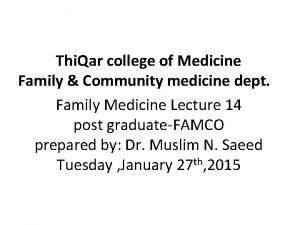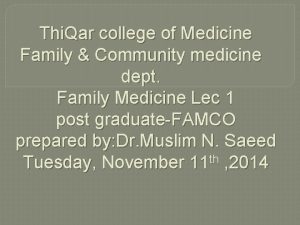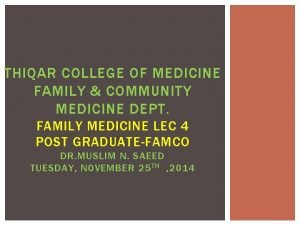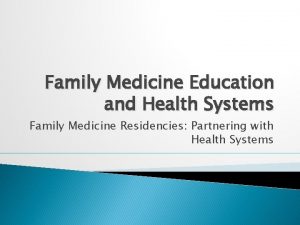Thi Qar college of Medicine Family Community medicine

























- Slides: 25

Thi. Qar college of Medicine Family & Community medicine dept. Foundation Lecture 9 communication prepared by: Dr. Muslim N. Saeed March 11 th, 2019

OBJECTIVES • At the end of this lecture, the student is expected to be able to: -Define some basic terms relevant to the topic of communication Describe how to promote an effective communication with the patient

COMMUNICATION -Diagnoses are usually made from the history and good history almost means that communication between doctor and patient have to be effective. -The essence of communication is 'the understanding of patient's feeling by the clinician. -The expression of empathy is regarded as an important component of medical interviewing. -There is a relationship between the quality of doctor's communication skills, and patient treatment.

• What do patients want? 1 -Humaneness 2 -Competency 3 -Accuracy 4 -Patient's involvement in decisions and time for care

-Patients want doctor to listen and who does not hurry them, and provision of information and opportunities for participation. -Doctors with good communication skills have greater job satisfaction, less work related stress, identify patient's problems more accurately, and their patients adjust better psychologically and are more satisfied with their care.

PROMOTING COMMUNICATION 1 - Ensure privacy 2 - Establishing rapport 3 - Respect confidentiality 4 - Use words the patient will understand 5 - Ensure that patients can hear what you are saying 6 - Introducing yourself to the patient 7 - Discover the agenda 8 - Communicate rapidly if necessary

PROMOTING COMMUNICATION 1 - Ensure privacy When interviewing patients it is necessary for both parties to develop confidence and rapport quickly so that mutual trust can be established.

2 - Establishing rapport Rapport is a close and harmonious relationship in which the people understand each other's feelings or ideas and communicate well. A. Adapt a worm friendly manner B. Give your full attention C. Listen carefully and show interest D. appear encouraging E. Make reflective comments "yes, I see that" to show you are listening F. facial expression (do not appear bored) G. Establish eye contact H. Make clarifying comments "so you mean that. . . " I. Apologize for any interruptions occurs

3 - Respect confidentiality Problems arise when people want to discuss problems involving others, usually relatives. 4 - Use words the patient will understand -Avoid medical jargon. Patients may not understand medical jargon. -Be aware that words may have different meaning in different contexts.

5 - Ensure that patients can hear what you are saying Patients who appear unintelligent or demented may appear so because they are deaf. In any event, do not speak too fast. 6 - Introducing yourself to the patient The greeting may be different depend on circumstances: Names Opening the conversation Should you shake hands? Should you stand to greet the patient?

7 - Discover the agenda "What can I do for you? " or "What is the matter? ". 8 - Communicate rapidly if necessary Average consultation time is about seven minutes. Try to appear unhurried. Within few minutes of interview, you should have assessed: -what the complaints are -whethere is a hidden agenda -what further questions you need to have answered.

Types of Communication 1. Verbal Communication: Much of the communication process in the clinical interview. 2. Non-verbal Communication : Communication between two people is usually onethird non-verbal. What is said verbally often is emphasized nonverbally, and personal attitudes and emotions usually are communicated at the nonverbal level.


TYPES OF DOCTOR-PATIENT RELATIONSHIPS 1. Default 2. Paternalism 3. Consumerism 4. Mutuality (Partnership)

1. Default - Patient and doctor have low control the patient adopts a passive role even when the doctor reduces some of his/her control. This type of relationship is neither professional nor effective.

2. Paternalism - Doctor has high control (Disease Model) In this type of relationship, the physician is dominant and chooses what he/she believes to be in the patient‘s best interest. Some patients even found it comforting to be able to rely on the doctor and be relieved of burdens of worry and decision making.

3. Consumerism - Patient has high control A consumerist relationship describes a situation in which the patient takes the active role and the doctor adopts a passive role, agreeing to the patient‘s requests for a second opinion, referral to hospital, a sick note, etc. This is typical in private practice.

4. Mutuality (Partnership) - Patient and doctor have high control (Illness Model) A relationship of mutuality is characterized by the active involvement of patients, where both patient and physician participate in the exchange of ideas and sharing of belief systems.

Difficulties in communication poor communication is the most important factor causing complaints from patients and relatives against doctors. Effective communication depends on four interrelated factors concerning the message the doctor (the sender), the patient (the recipient), the message itself and the environment in which the message is sent.


The environment The physical environment is important. 1 -The appearance, size of consulting rooms, waiting rooms will affect communication, especially if privacy is threatened. 2 -The doctor can create an obstacle simply by a physical ‘barrier’, for example, a large desk. 3 -A busy practice (time)will influence communications seriously.


The message The nature and content of the message may be uncomfortable for the doctor or the patient or both. such as sexual problems, malignant disease, drug abuse , and psychiatric disorders. The patient may find the message difficult to understand. Failure to reassure the patient (where appropriate) distracts the patient.

The doctor Although most doctors satisfactorily meet professional standards, there are times when the communication is adversely affected by chronic tiredness, stress, domestic problems and poor health.

End
 Types of family in community medicine
Types of family in community medicine Types of family in community medicine
Types of family in community medicine Duke medicine grand rounds
Duke medicine grand rounds Qar strategy lesson plan
Qar strategy lesson plan Question and answer relationship
Question and answer relationship Qar comprehension
Qar comprehension Qar test
Qar test Kecdi deniz asdi dag
Kecdi deniz asdi dag Qar visuals
Qar visuals Qar visuals
Qar visuals Tế bào thụ cảm thị giác
Tế bào thụ cảm thị giác Cấu tạo kính tiềm vọng
Cấu tạo kính tiềm vọng Bé thì chăn nghé chăn trâu
Bé thì chăn nghé chăn trâu Bớt đầu thì bé nhất nhà
Bớt đầu thì bé nhất nhà Mode địa chỉ tức thì là mode
Mode địa chỉ tức thì là mode Nguyễn thị cẩm châu
Nguyễn thị cẩm châu Các kiểu bố trí thí nghiệm
Các kiểu bố trí thí nghiệm Riskman report
Riskman report Creative thi
Creative thi Cc transistor
Cc transistor Thuy ha
Thuy ha Pham thi thanh thao
Pham thi thanh thao Thí nghiệm nhận biết ion photphat
Thí nghiệm nhận biết ion photphat đồ thị phụ tải
đồ thị phụ tải Nguyễn thị diễm my
Nguyễn thị diễm my Thực hành một số thí nghiệm về enzim
Thực hành một số thí nghiệm về enzim
